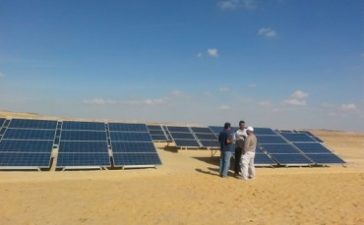 In 2014, Dutch designer Daan Roosegaarde created a bike path that glows at night thanks to absorbed solar energy. Now manufacturers are tackling larger roads, building energy-producing highways that can generate solar energy and send it directly to existing power grids. French infrastructure company Colas, a subsidiary of Bouygues SA, has developed “Wattway”, a photovoltaic (PV) road surface with planned projects across four continents.
In 2014, Dutch designer Daan Roosegaarde created a bike path that glows at night thanks to absorbed solar energy. Now manufacturers are tackling larger roads, building energy-producing highways that can generate solar energy and send it directly to existing power grids. French infrastructure company Colas, a subsidiary of Bouygues SA, has developed “Wattway”, a photovoltaic (PV) road surface with planned projects across four continents.
Colas’ Wattway technology differs from other PV solutions in that it does not require need the existing road infrastructure to be re-engineered. Instead, thin PV panels are applied directly on the pavement. The concept aims to generate green electricity while also allowing uninterrupted traffic flow.
 The 7-mm-thick panels are made from layered solar cells – similar to those used in flexible roof membranes – encapsulated in a resin substrate which keeps them rainproof. The composition allows the panels to adapt to thermal dilation and contraction in the underlying pavement. All electrical wiring is embedded within the road surface and an anti-slip surface made from crushed glass tops the panels. The rugged system is capable of withstanding the weight of an 18-wheeler truck.
The 7-mm-thick panels are made from layered solar cells – similar to those used in flexible roof membranes – encapsulated in a resin substrate which keeps them rainproof. The composition allows the panels to adapt to thermal dilation and contraction in the underlying pavement. All electrical wiring is embedded within the road surface and an anti-slip surface made from crushed glass tops the panels. The rugged system is capable of withstanding the weight of an 18-wheeler truck.

“We wanted to find a second life for a road,” Philippe Harelle, the chief technology officer at Colas SA’s Wattway unit, told Bloomberg. “Solar farms use land that could otherwise be for agriculture, while the roads are free.”
In August, French energy minister Ségolène Royal inaugurated a new panel manufacturing plant located adjacent to Colas’ headquarters in the village of Tourouvre, in Normandy. The panels were previously manufactured at the Institut National de l’Energie Solaire (INES) laboratory in Le Bourget-du-Lac, but the new facility is expected to speed up the production. Following five years of research and lab testing, a pilot project is underway near the plant to create a 1-kilometer-long solar road that will generate enough electicity to power public street lighting for a town of 5,000 inhabitants.
 Colas is also constructing 100 field test sites. One site will be used to charge electric vehicles, another will power a small hydrogen production plant. Wattway has also installed its panels to illuminate electronic billboards.
Colas is also constructing 100 field test sites. One site will be used to charge electric vehicles, another will power a small hydrogen production plant. Wattway has also installed its panels to illuminate electronic billboards.
“We need to test for all kinds of different traffic and climate conditions,” said Harelle. “I want to find the limits of it. We think that maybe it will not be able to withstand a snow plow.” The manufacturer says that a Wattway panel can last at least 10 years depending on the traffic, which speeds up wear. If the section is not covered by heavy traffic – a stadium parking lot for example – then Wattway panels can last roughly 20 years.
The French government has stated plans to pave 1,000 kilometers of road with solar panels over the next five years, and is supporting panel development with €5 million in state funding. When the project is complete, the electric roadways will be able to supply power for about 8% of the French population, or 5 million people.
The next two installations will be in Calgary, Canada and in Georgia, USA. Wattway also has projects planned in Africa, Japan and other European Union nations.
In the past five years, prices for solar technology prices have plummeted, making solar an economical alternative to fossil fuels. But costs of the solar roadway may remain an obstacle to wider commercial application. As reported by Bloomberg, a square meter of solar road (including monitoring, data collection and installation) currently costs €2,500. Wattway says it can make the price competitive with traditional solar farms by 2020.
As for incorporating PV in civil infrastructure, Bloomberg New Energy Finance analyst Pietro Radoia said, “On roads, I don’t think that it will really take off unless there’s a shortage of land sometime in the future.”’
Colas will include Wattway panels in their product line in 2017, even offering larger sized panel surfaces. A spokeman said they plan to commercialize the technology in 2018, and expect to have the product available within the next three years for installation on private roads and driveways.



